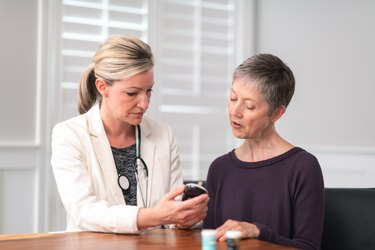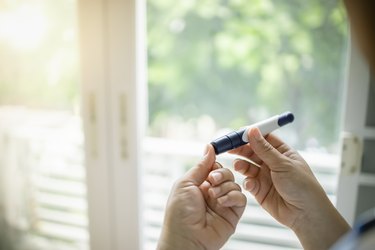
If you're at risk for diabetes, you may be wondering what a normal blood sugar range for women is. The answer to that question can vary, however, from test to test.
What Is Glucose and Why Is It Important?
Video of the Day
Glucose is the main type of sugar in the body that's formed from the foods and drinks you consume, according to the U.S. National Library of Medicine (NLM). Glucose is the primary energy source that's sent throughout your system to the body's cells.
Video of the Day
Keep in mind that blood sugar isn't the villain that some people make it out to be — it plays a crucial role in keeping your body functioning properly. Your cells require glucose for essential functions like keeping your heart beating and your muscles pumping.
But when blood sugar levels are too high, it can lead to damage to both small and large blood vessels as well as nerves, which in turn can cause problems with your heart, kidneys and eyes. Glucose in your blood is measured in mg/dL (or milligrams per deciliter).
Two hours after eating a meal, normal blood sugar levels are less than 140 mg/dL. This is true regardless of what you've eaten.
What Are Normal Blood Sugar (Glucose) Levels for Women?
When it comes to measuring your blood sugar level, much depends on when the test is given and whether you've eaten anything. (More on common types of tests in a moment.) Take a look at the chart below to see normal glucose levels, as well as the levels that can indicate prediabetes or diabetes, per the Centers for Disease Control and Prevention (CDC).
A1C Test | Fasting Blood Sugar Test | Glucose Tolerance Test | |
|---|---|---|---|
Normal | Below 5.7% | 99 mg/dL or lower | 140 mg/dL or lower |
Prediabetes | 5.7-6.4% | 100-125 mg/dL | 140-199 mg/dL |
Diabetes | 6.5% or higher | 126 mg/dL or higher | 200 mg/dL or higher |
If you have diabetes, it's critical to learn the best target numbers for your particular case, depending on your age and health status. Here's what the American Diabetes Association recommends in terms of blood sugar range goals:
- Before meals 80 mg/dL to 130 mg/dL
- After meals Less than 180 mg/dL two hours after eating
When it comes to diabetes testing, one abnormal test result is not considered definitive.
Common Tests to Check Blood Glucose Levels
Health care providers can use a variety of laboratory tests to check blood sugar levels and determine whether a woman has diabetes. Some of these tests require fasting for 8 hours before blood is drawn. Blood glucose levels that are too high suggest insufficient insulin production, reduced insulin sensitivity or a combination of the two — and could mean that you have diabetes.
Here are the most common tests that doctors use to check blood glucose levels:
- A1C Test: If you took a fasting blood glucose test and saw that your numbers were high, your doctor may recommend an A1C test, says Erin Palinski-Wade, RD, CDE, author of 2-Day Diabetes Diet. An A1C test is a blood test that shows a person's average blood sugar levels over a 3-month period of time, according to the NLM. "The A1C really gives you an idea of what's been going on for 24 hours a day for the last 3 months and gives you a clearer picture if a person is at a significant risk for diabetes or already has it," Palinski-Wade says.
- Fasting Glucose Levels: The most common test for blood sugar is the fasting plasma or blood glucose test (FBG). For an accurate reading, it is necessary to fast for at least 8 hours beforehand, according to the NLM.
- Oral Glucose Tolerance Test: Health care providers can also assess the ability of your body to metabolize sugar with an oral glucose tolerance test (OGTT). During this test, you'll fast for 8 hours before giving your doctor a sample of blood. Then you'll drink a sugar liquid during the next few hours, during which time your blood will be taken every 30 to 60 minutes, according to the NLM.
When it comes to diabetes testing, one abnormal test result is not considered definitive. If any of these tests show results above the normal range for women, expect your doctor to request a second test — either a repeat of the one you already took or another of the diagnostic tests.
How Often Should You Be Screened?
Every adult woman and man over the age of 45 should be screened for diabetes every 3 years, according to the NLM.
If you have risk factors for diabetes, or if you have prediabetes or symptoms that indicate you may have high blood glucose — such as increased thirst, frequent urination, blurry vision or unexplained weight loss — you may want to be screened at an earlier age (or more often).
Along with age, common risk factors for diabetes, according to the American Diabetes Association's 2019 Standards of Care, include:
- Family history: Your risk is higher if you have a first-degree relative (like a parent, sibling or child) with diabetes.
- Race and ethnicity: African American, Latino, Native American, Asian American and Pacific Islander folks are at a higher risk of diabetes.
- Health conditions: If you have a history of cardiovascular disease or hypertension, or if you have polycystic ovary syndrome, you have a higher likelihood of a diabetes diagnosis. Low levels of HDL cholesterol or high levels of triglycerides are also a risk factor.
- Obesity: Having either overweight or obesity is a risk factor for diabetes.
What Factors Affect a Woman's Blood Sugar Levels?
A woman's blood sugar levels may be high (hyperglycemic) or low (hypoglycemic). These are the several considerations that can affect glucose levels in each case:
Hyperglycemia Factors
Here are some of the reasons why your blood sugar may be high, per the Mayo Clinic:
- Little or no physical activity
- Physical or emotional stress or physical injury (surgery, illness)
- Certain foods with a high glycemic load — this means they are more likely to cause blood sugar to fluctuate, per the Harvard T.H. Chan School of Public Health. These foods include processed white products (pasta, cereals, bread, rice), candy, sweet beverages and french fries
- Dehydration
- Some drugs, especially steroids
- Taking medications incorrectly
Other factors that can impact a woman's blood sugar levels include menstruation and menopause, both of which cause hormonal changes.
Hypoglycemia Factors
Potential causes of low blood sugar include the following, per the CDC:
- Incorrect or mistimed doses of insulin
- Too few carbs to balance insulin dose
- Drinking alcohol
- Heat and humidity
- Experiencing high altitude
- Puberty and menstruation
What Are the Common Symptoms of Irregular Blood Sugar Levels in Women?
Blood sugar levels can be irregular in two ways, spiking high or dropping dangerously low. Keep in mind that it's extremely important for someone with Type 1 diabetes to know the signs of high blood sugar. Left untreated, hyperglycemia can rapidly become emergent. Here are the common symptoms you might experience with both high and low blood sugar:
Symptoms of High Blood Sugar
- Unusual thirst and hunger
- Blurry vision
- Frequent urination
- Headache, fatigue
- Weight loss
- Sores and infections that are slow to heal
Symptoms of Low Blood Sugar
- Rapid heartbeat
- Shaking, sweating
- Anxiety, nervousness
- Irritability, confusion
- Hunger
- Dizziness
- U.S. National Library of Medicine: "Type 2 Diabetes; 2011"
- American Diabetes Association: "Standards of Medical Care in Diabetes"
- U.S. National Library of Medicine: "Blood Sugar Test"
- U.S. National Library of Medicine: "Glucose Tolerance Test - Non-Pregnant"
- U.S. National Library of Medicine: "A1C Test"
- Mayo Clinic: Blood Sugar Testing - Why, When, and How
- Cleveland Clinic: Hyperglycemia (High Blood Sugar)
- U.S. National Library of Medicine: "Blood Sugar"
- Centers for Disease Control and Prevention: "Diabetes Tests"
- Mayo Clinic: "Blood sugar levels can fluctuate for many reasons"
- Harvard T.H. Chan School of Public Health: "Carbohydrates and Blood Sugar"
- CDC: "Low Blood Sugar (Hypoglycemia)"
Is this an emergency? If you are experiencing serious medical symptoms, please see the National Library of Medicine’s list of signs you need emergency medical attention or call 911.


